Define Radicand and Give an Example
Square and Cube Roots
Recall that a square rootA number that when multiplied by itself yields the original number. of a number is a number that when multiplied by itself yields the original number. For example, 5 is a square root of 25, because Since , we can say that −5 is a square root of 25 as well. Every positive real number has two square roots, one positive and one negative. For this reason, we use the radical sign to denote the principal (nonnegative) square rootThe positive square root of a positive real number, denoted with the symbol and a negative sign in front of the radical to denote the negative square root.
Zero is the only real number with one square root.
Example 1
Evaluate.
Solution:
If the radicandThe expression A within a radical sign, , the number inside the radical sign, can be factored as the square of another number, then the square root of the number is apparent. In this case, we have the following property:
Or more generally,
The absolute value is important because a may be a negative number and the radical sign denotes the principal square root. For example,
Make use of the absolute value to ensure a positive result.
Example 2
Simplify:
Solution:
Here the variable expression could be negative, zero, or positive. Since the sign depends on the unknown quantity x, we must ensure that we obtain the principal square root by making use of the absolute value.
Answer:
The importance of the use of the absolute value in the previous example is apparent when we evaluate using values that make the radicand negative. For example, when ,
Next, consider the square root of a negative number. To determine the square root of −25, you must find a number that when squared results in −25:
However, any real number squared always results in a positive number. The square root of a negative number is currently left undefined. For now, we will state that is not a real number. Therefore, the square root functionThe function defined by given by is not defined to be a real number if the x-values are negative. The smallest value in the domain is zero. For example, and Recall the graph of the square root function.
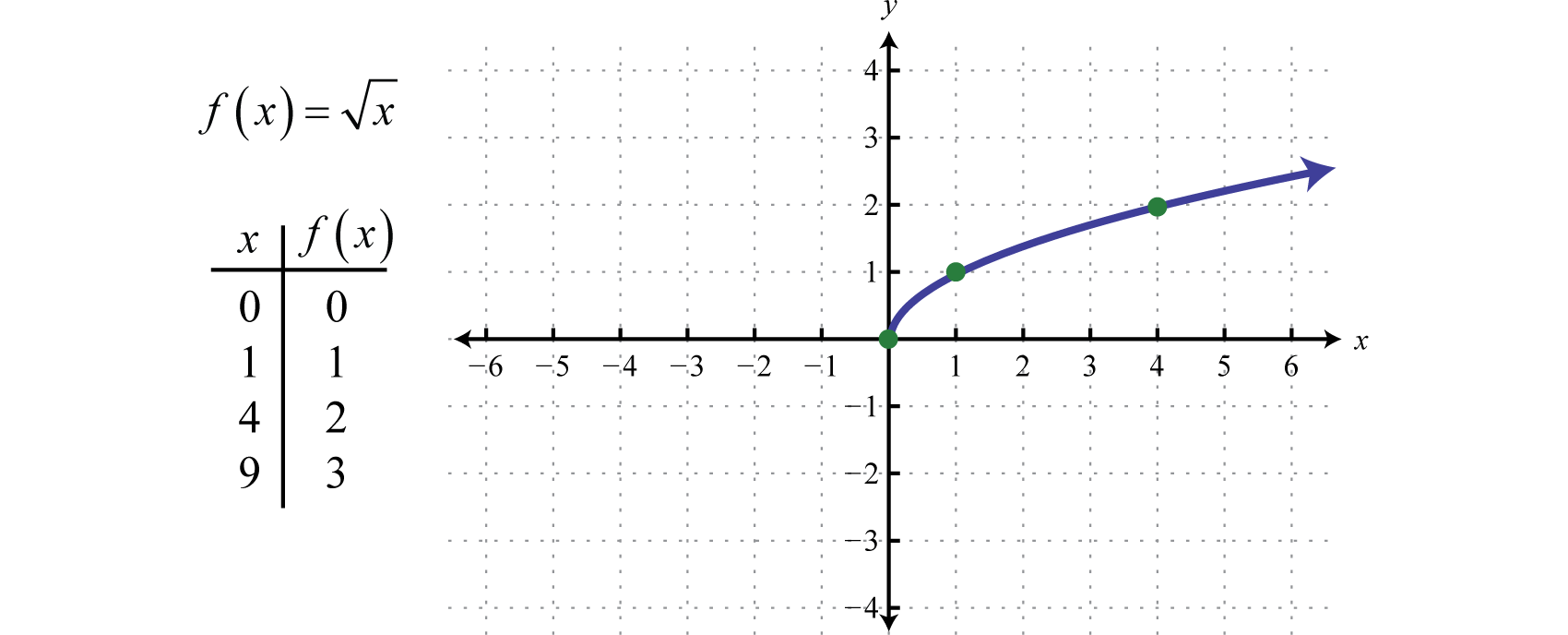
The domain and range both consist of real numbers greater than or equal to zero: To determine the domain of a function involving a square root we look at the radicand and find the values that produce nonnegative results.
Example 3
Determine the domain of the function defined by
Solution:
Here the radicand is This expression must be zero or positive. In other words,
Solve for x.
Answer: Domain:
A cube rootA number that when used as a factor with itself three times yields the original number, denoted with the symbol of a number is a number that when multiplied by itself three times yields the original number. Furthermore, we denote a cube root using the symbol , where 3 is called the indexThe positive integer n in the notation that is used to indicate an nth root. . For example,
The product of three equal factors will be positive if the factor is positive and negative if the factor is negative. For this reason, any real number will have only one real cube root. Hence the technicalities associated with the principal root do not apply. For example,
In general, given any real number a, we have the following property:
When simplifying cube roots, look for factors that are perfect cubes.
Example 4
Evaluate.
Solution:
It may be the case that the radicand is not a perfect square or cube. If an integer is not a perfect power of the index, then its root will be irrational. For example, is an irrational number that can be approximated on most calculators using the root button Depending on the calculator, we typically type in the index prior to pushing the button and then the radicand as follows:
Therefore, we have
Since cube roots can be negative, zero, or positive we do not make use of any absolute values.
Example 5
Simplify:
Solution:
The cube root of a quantity cubed is that quantity.
Answer:
Try this! Evaluate:
Answer: −10
Next, consider the cube root functionThe function defined by :
Since the cube root could be either negative or positive, we conclude that the domain consists of all real numbers. Sketch the graph by plotting points. Choose some positive and negative values for x, as well as zero, and then calculate the corresponding y-values.
Plot the points and sketch the graph of the cube root function.

The graph passes the vertical line test and is indeed a function. In addition, the range consists of all real numbers.
Example 6
Given , find , , , and Sketch the graph of
Solution:
Replace x with the given values.
We can also sketch the graph using the following translations:
Answer:
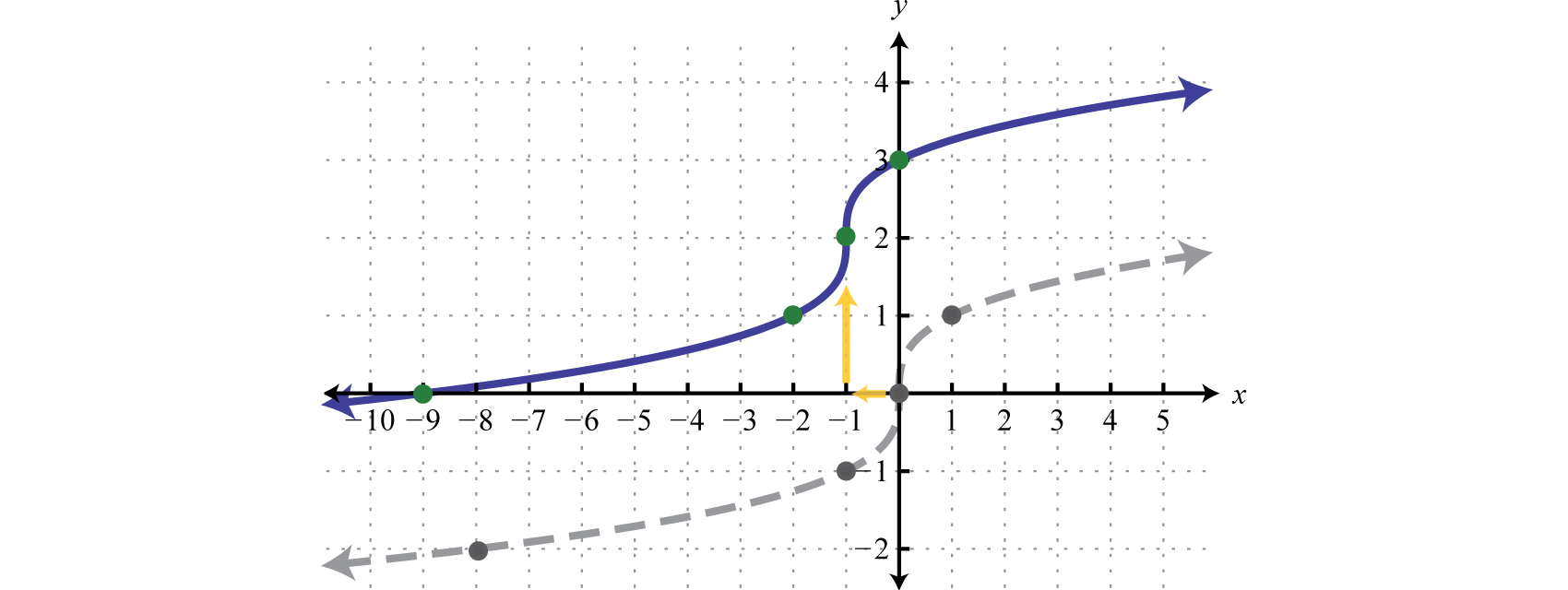
nth Roots
For any integer , we define an nth rootA number that when raised to the nth power yields the original number. of a positive real number as a number that when raised to the nth power yields the original number. Given any nonnegative real number a, we have the following property:
Here is called the index and is called the radicand. Furthermore, we can refer to the entire expression as a radicalUsed when referring to an expression of the form . When the index is an integer greater than or equal to 4, we say "fourth root," "fifth root," and so on. The nth root of any number is apparent if we can write the radicand with an exponent equal to the index.
Example 7
Simplify.
Solution:
Note: If the index is , then the radical indicates a square root and it is customary to write the radical without the index;
We have already taken care to define the principal square root of a real number. At this point, we extend this idea to nth roots when n is even. For example, 3 is a fourth root of 81, because And since , we can say that −3 is a fourth root of 81 as well. Hence we use the radical sign to denote the principal (nonnegative) nth rootThe positive nth root when n is even. when n is even. In this case, for any real number a, we use the following property:
For example,
The negative nth root, when n is even, will be denoted using a negative sign in front of the radical
We have seen that the square root of a negative number is not real because any real number that is squared will result in a positive number. In fact, a similar problem arises for any even index:
We can see that a fourth root of −81 is not a real number because the fourth power of any real number is always positive.
You are encouraged to try all of these on a calculator. What does it say?
Example 8
Simplify.
Solution:
Since the indices are even, use absolute values to ensure nonnegative results.
- is not a real number.
When the index n is odd, the same problems do not occur. The product of an odd number of positive factors is positive and the product of an odd number of negative factors is negative. Hence when the index n is odd, there is only one real nth root for any real number a. And we have the following property:
Example 9
Simplify.
Solution:
Since the indices are odd, the absolute value is not used.
In summary, for any real number a we have,
When n is odd, the nth root is positive or negative depending on the sign of the radicand.
When n is even, the nth root is positive or not real depending on the sign of the radicand.
Try this! Simplify:
Answer: 16
Simplifying Radicals
It will not always be the case that the radicand is a perfect power of the given index. If it is not, then we use the product rule for radicalsGiven real numbers and , and the quotient rule for radicalsGiven real numbers and , where to simplify them. Given real numbers and ,
| Product Rule for Radicals: |
|
| Quotient Rule for Radicals: |
|
A radical is simplifiedA radical where the radicand does not consist of any factors that can be written as perfect powers of the index. if it does not contain any factors that can be written as perfect powers of the index.
Example 10
Simplify:
Solution:
Here 150 can be written as
We can verify our answer on a calculator:
Also, it is worth noting that
Answer:
Note: is the exact answer and 12.25 is an approximate answer. We present exact answers unless told otherwise.
Example 11
Simplify:
Solution:
Use the prime factorization of 160 to find the largest perfect cube factor:
Replace the radicand with this factorization and then apply the product rule for radicals.
We can verify our answer on a calculator.
Answer:
Example 12
Simplify:
Solution:
Here we note that the index is odd and the radicand is negative; hence the result will be negative. We can factor the radicand as follows:
Then simplify:
Answer:
Example 13
Simplify:
Solution:
In this case, consider the equivalent fraction with in the numerator and in the denominator and then simplify.
Answer:
Try this! Simplify:
Answer:
Key Takeaways
- To simplify a square root, look for the largest perfect square factor of the radicand and then apply the product or quotient rule for radicals.
- To simplify a cube root, look for the largest perfect cube factor of the radicand and then apply the product or quotient rule for radicals.
- When working with nth roots, n determines the definition that applies. We use when n is odd and when n is even.
- To simplify nth roots, look for the factors that have a power that is equal to the index n and then apply the product or quotient rule for radicals. Typically, the process is streamlined if you work with the prime factorization of the radicand.
Topic Exercises
-
-
-
-
-
-
-
-
-
-
-
-
-
-
-
-
-
-
-
-
-
-
-
-
-
-
-
-
-
-
-
-
-
-
-
-
-
-
-
-
-
Given , find , , and
-
Given , find , , and
-
Given , find , , and
-
Given , find , , and
-
Given , find , , and
-
Given , find , , and
-
Given , find , , and
-
Given , find , , and
-
-
-
-
-
-
-
-
-
-
-
-
Part A: Square and Cube Roots
Simplify.
Determine the domain of the given function.
Evaluate given the function definition.
Sketch the graph of the given function and give its domain and range.
Part B: nth Roots
Simplify.
-
-
-
-
-
-
-
-
-
-
-
-
-
-
-
-
-
-
-
-
-
-
-
-
-
-
-
-
-
-
-
-
-
-
-
-
-
-
-
-
-
-
-
-
-
-
-
-
-
-
-
-
-
Each side of a square has a length that is equal to the square root of the square's area. If the area of a square is 72 square units, find the length of each of its sides.
-
Each edge of a cube has a length that is equal to the cube root of the cube's volume. If the volume of a cube is 375 cubic units, find the length of each of its edges.
-
The current I measured in amperes is given by the formula where P is the power usage measured in watts and R is the resistance measured in ohms. If a 100 watt light bulb has 160 ohms of resistance, find the current needed. (Round to the nearest hundredth of an ampere.)
-
The time in seconds an object is in free fall is given by the formula where s represents the distance in feet the object has fallen. How long will it take an object to fall to the ground from the top of an 8-foot stepladder? (Round to the nearest tenth of a second.)
Part C: Simplifying Radicals
Simplify.
Simplify. Give the exact answer and the approximate answer rounded to the nearest hundredth.
Rewrite the following as a radical expression with coefficient 1.
-
Explain why there are two real square roots for any positive real number and one real cube root for any real number.
-
What is the square root of 1 and what is the cube root of 1? Explain why.
-
Explain why is not a real number and why is a real number.
-
Research and discuss the methods used for calculating square roots before the common use of electronic calculators.
Part D: Discussion Board
Answers
-
6
-
-
−4
-
5
-
Not a real number
-
−3
-
-
-
4
-
−6
-
−2
-
2
-
-
-
-
-
-
-
-
-
; ;
-
; ;
-
; ;
-
; ;
-
Domain: ; range:
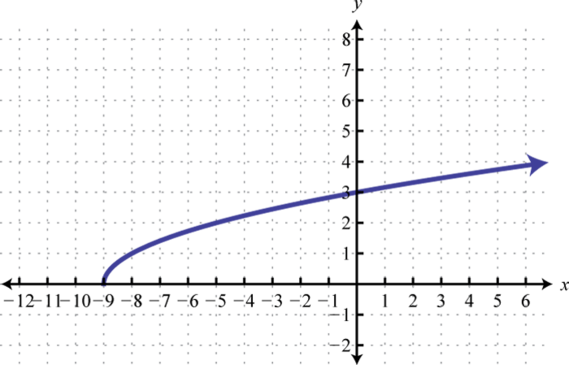
-
Domain: ; range:
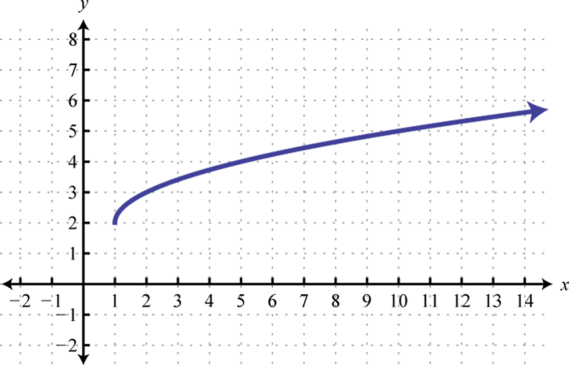
-
Domain: ; range:
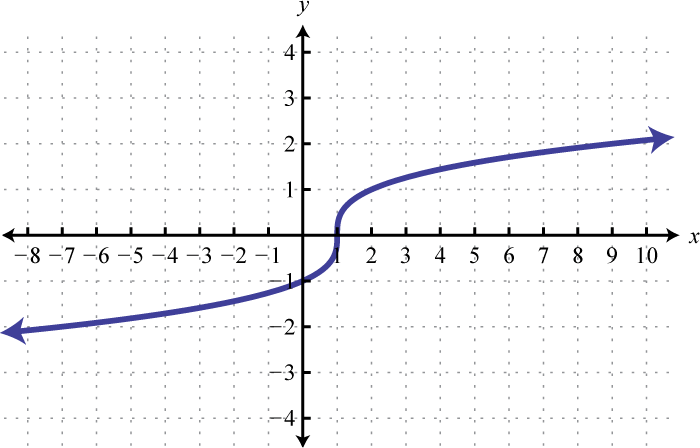
-
Domain: ; range:
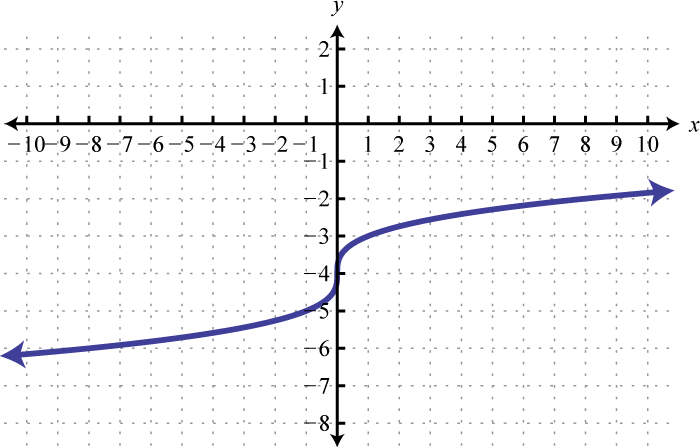
-
Domain: ; range:
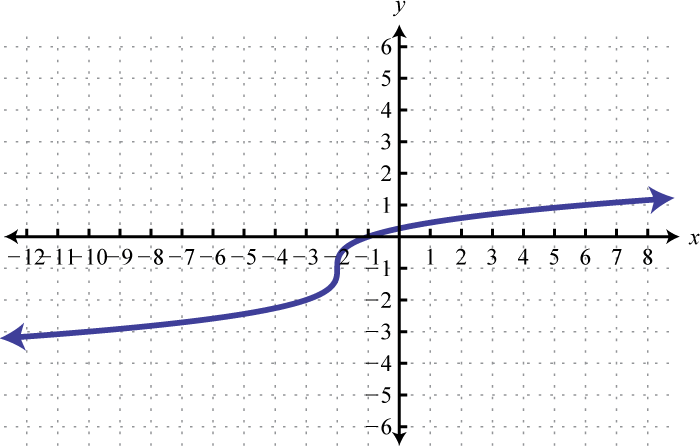
-
Domain: ; range:
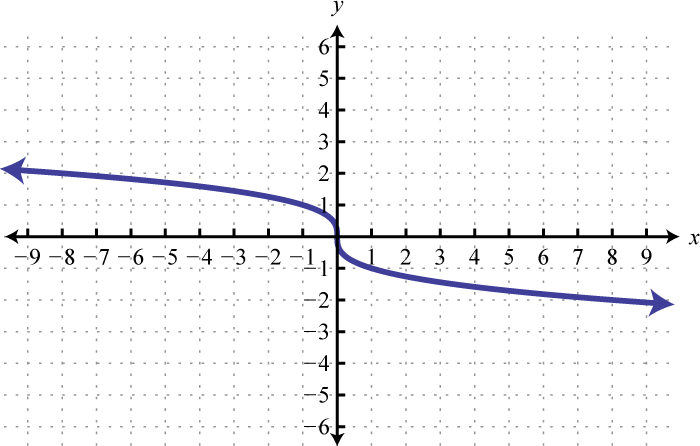
-
4
-
5
-
4
-
3
-
-
−2
-
−2
-
Not a real number
-
18
-
−20
-
Not a real number
-
-
3
-
-
20
-
-
-
-
-
-
-
-
-
-
-
-
-
-
-
-
-
-
; 7.75
-
; 1.40
-
; 6.21
-
; 1.32
-
; 4.70
-
-
-
-
-
units
-
Answer: 0.79 ampere
-
Answer may vary
-
Answer may vary
Define Radicand and Give an Example
Source: https://saylordotorg.github.io/text_intermediate-algebra/s08-01-roots-and-radicals.html
0 Response to "Define Radicand and Give an Example"
Post a Comment